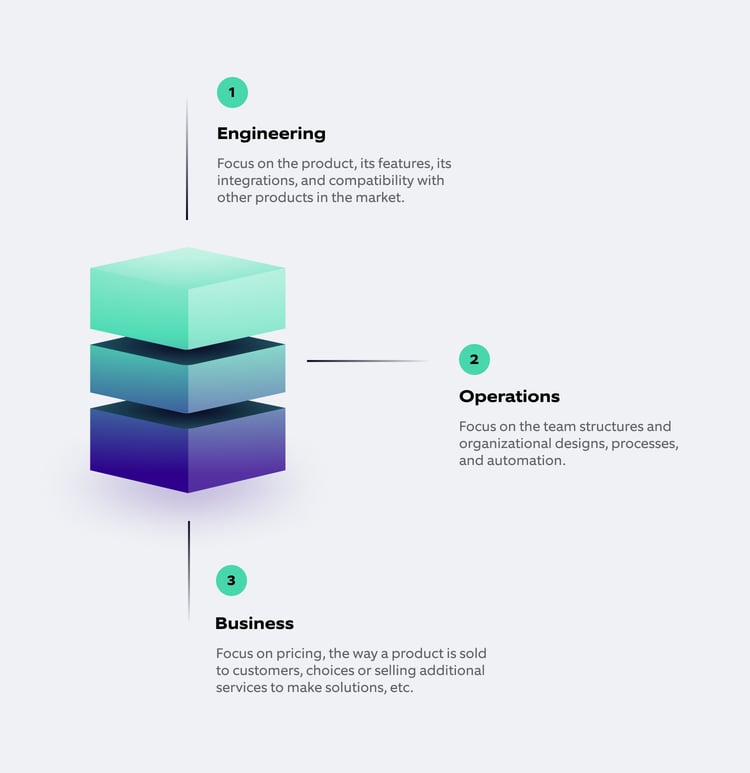A couple of decades ago, if you wanted to watch cricket, you had to purchase a complete cable TV package – regardless of whether you those other channels. Today, DTH broadcasting services allow users to choose their packages or channels and pay accordingly.
The music industry was similar. CDs were available with a bunch of songs. Not all tracks had the same wavelength/popularity. This was until the introduction of websites that allowed songs to be downloaded individually and saved in an MP3. Today, digital music service companies, like Spotify, bundle songs as per the listener's preference and history into a playlist and sell them as a subscription.
The music and entertainment industry has not been the only one following the bundling, unbundling, and re-bundling cycle. When Apple introduced iTunes, it unbundled albums and CDs. Now it provides Apple One, an all‑in‑one subscription that bundles up its six services, TV, Music, Arcade, iCloud, News, and Fitness. Microsoft also offers a suite of cloud-based productivity applications, including Word, Excel, PowerPoint, Teams, Outlook, etc., bundled as Microsoft 365. Notably, these were once sold individually. And the list goes on!
So what does that mean for engineering, and why are we even speaking about it?
Bundling vs. Unbundling of products/services
Bundling combines multiple services/products to generate value and create a level of differentiation from the competition. Usually, when a company gains monopoly power, it uses bundling to provide its customers with a whole set of products on one platform and lock them while increasing the average order value.
On the flip side, unbundling is selling products/services independently. Both ways, as quoted by Jim Barksdale, are the only two ways of making money. Customers often gravitate toward purchasing offers that have just the things they are interested in; some prefer buying bundled products to save money and gain value.
With rapid technological advancement, industry lifecycles have shortened, and unequal consumer pockets have been created. This, in turn, has led to aggregation and disaggregation happening simultaneously. For example, eCommerce marketplaces like Amazon, eBay, Walmart, etc., have unbundled into hundreds of vertical brands that are bundled by horizontal direct-to-consumer aggregators. While vertical brands refer to businesses that serve a specific niche or group of people in a market, horizontal brands serve various buyers across different verticals. For example, Google is a horizontal company that serves various verticals and industries, and Uber is a vertical brand that serves customers with cab services.
Re-bundling can be adopted only when the organization has newer distribution channels to offer more choices to consumers. As an example, while a baby boomer must have read printed newspapers, accessed cable TV to watch shows and CD to listen to music, a GenZ gets all this and much more on applications like YouTube, Facebook, Twitter, Instagram, etc., directly on their smartphones.
A report by GP Bullhound titled, 'Global Software Market Perspectives Q4 2021', states that as the trend of unbundling is accelerating, the need for comprehensive API integration between them has become critical. It further gives the example of companies like Airtable and Coda that are unbundling Excel spreadsheets into interactive databases. Also, companies like Zapier are creating holistic API integration platforms for users to create an easy-to-use digital shelf of their favorite SaaS products.
Read on as we explore how we are living in a bundled and unbundled world – at the same time.
Multiple dimensions of bundling and unbundling of products/services
For a product organization, the bundling/unbundling happens across these three following layers:
- Engineering
- Operations
- Business

In this section, let's deep dive into use cases of bundling and unbundling across the layers of a software company:
Engineering
- Architecture: From monolithic to a microservices architecture
As per research by IMARC Group, the microservices architecture market size is expected to reach a value of US$ 6.84 Billion by 2027, exhibiting a growth rate (CAGR) of 15.70% during 2022-2027. While monolithic architecture refers to a traditional unified model software program in a tightly coupled architecture, microservice architecture is a loosely coupled system where each component works independently as a suite of small services but functions as a single unified solution.
As monolithic systems become too large to deal with, enterprises are today migrating to microservices architectures to get:- Faster response to customer needs by minimizing downtime to push new updates
- Improved operational efficiency while managing critical features
For example, one of our clients, a leading company focusing on cloud modernization, chose to opt for a microservice architecture when it decided to rewrite a significant chunk of its digital commerce functionality. The client wanted to move away from lengthy release cycles of pushing upgrades once every six months by gaining the agility to push modern functionality to its channel and the end customer almost every month.
- User experience: From out-of-the-box to headless
With customer expectations and market trends evolving at a fast pace, digital businesses are moving towards headless web architecture. According to a WP Engine report, 92% of respondents say that headless architecture is one of the most effective solutions for businesses to deliver consistent content experiences.
At its core, headless web architecture dissociates the front end of a website (i.e., the graphical user interface) from the back end where the code and data live. In this architecture, the front-end and back-end work independently. The headless architecture consists of only the content database and a user interface for adding, modifying, and managing the content. The user must add APIs and a front-end development framework to publish the content.
There are several benefits of going headless, some of which are mentioned below:
- Provides an integrated experience that increases end-users' confidence to navigate safely performing critical transactions
- Gives better control of the layout and the design of the front end to the engineering team, making the end-user experience more personal.
- Makes it vendor-agnostic with respect to the underlying systems – if you are a big firm continuously acquiring companies, the new companies can seamlessly integrate through headless front ends.
The digital strategy of businesses today is not limited to websites. The headless architecture enables them to deliver content across the ecosystem (applications, social media, smart devices, etc.) to interact with customers and grow their presence continuously.
For example, one of our clients wanted to opt for value-based pricing for its channel. While the model was supported in the client's CPQ system, they chose the headless front end because it allowed them to experiment with something new for a select channel partner ecosystem. The experiment's success helped them extend the functionality such that generating quotes became a self-service. This transformation created operational efficiency at a global scale, helping them save millions.
Operations
Examples of bundling/unbundling are common in how team structures are designed. Having smaller agile teams is common in the software industry, but there are scenarios where decisions must be taken on functions like:
- QA
- SRE
- Design
- DevOps
- Architecture
Decisions can be around:
- When to create a central function that works like an independent enablement group responsible for creating frameworks that all Scrum feature teams will use?
- Should a function like QA, Design, or DevOps be part of every Scrum feature team, or should it work through independent central groups?
Depending on the product's maturity, these decisions to bundle or unbundle can be made.
For example, a young startup recently achieved product-market fit, successfully acquired hundreds of customers, and closed a major funding round. While more features had to be built through new funds, the client realized it needed to invest in a central team that started the automation journey for the business to scale to its ambition. So, the core team was unbundled – a few engineers were assigned a job to create a central function that would be responsible for setting up the base framework for performing automation of front-end use cases.
In another use case, a mature client lacked capability in reliability and resilience and wanted to ensure developers tested complex scenarios before checking in code to production. The client created a new team that first built the shift-left framework at scale. Then, this central group started creating champions in various feature teams to enable them to self-service and make use of the new framework. So, the bundle and unbundle approach helped create operational efficiency, enabling the same engineers to do more with less.
Business
When products are bundled together, enterprises often sell them at a reduced price to provide value and encourage customers to buy more than they otherwise would.
On the other hand, when you unbundle your products/services and sell them individually, you are enabling customers to buy products at a reasonable price.
While neither of the ways is right or wrong, an appropriate pricing strategy helps businesses identify the pricing formula that is in line with their business models and customer needs.
For instance, a client from the audit industry had deployed multiple unique models to cater to different industries. They realized the unbundled approach, although verticalized, was not designed efficiently to scale the business. There was a lot of repetition in code and logic, while there were inefficiencies because similar things were built using different technologies. This led the company to make a decision to bundle at an engineering level, implying there will be a single code base with microservice architecture, and the business layer will now operate as a unified SaaS product irrespective of the industry where it will be applied. So, the client chose to move from an unbundled to a bundled state, offering more value to the customer.
In another example, a client acquired a company to start offering bundled solutions. The change was immediately reflected in their pricing strategy and how the product was sold. While they immediately saw growth through the bundling, the engineering was not bundled as expected. This eventually led to a dip in the product's NPS.
So, are you bundling, unbundling, or re-bundling your products/services?
Knowing when to bundle or unbundle majorly depends on your industry and the type of products/services you offer.
With our enterprise architecture and solution consulting services coupled with agile methodology, we can help you find the best application of the pattern (bundle, unbundle, or re-bundle) specific to your industry vertical and the products/services you deal in. If you want to innovate by implementing bundling or unbundling patterns, please connect with us by clicking here.






